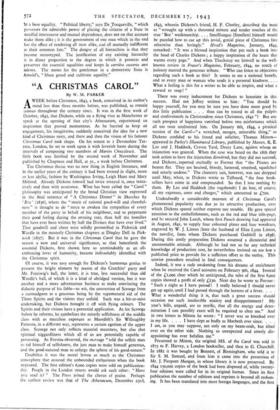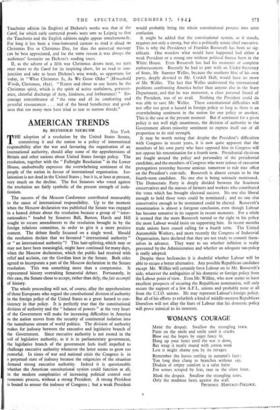"A CHRISTMAS CAROL"
By W. M. PARKER
AWEEK before Christmas, 1-843, a book, conceived in its author's mind less than three months before, was published, to remain iamous throughout the century since. It was in ,the first week of October, 1843, that Dickens, while on a flying visit to Manchester to speak at the opening of that city's Athenaeum, experienced an
inspiration that proved momentous. As he hurried to keep an engagement, his imagination suddenly conceived the idea for a new kind of Christmas story, and there and then the vision of his famous Christmas Carol took shape. On his return to r Devonshire Ter- race, London, he set to work upon it with feverish haste during the intervals of composing two numbers of Martin Chuzzlewit. The little book was finished by the second week of November and published by Chapman and Hall, at 5s., a week before Christmas.
The Christmas theme was no new thing in English literature, and in the earlier years of the century it had been treated in slight, more or less idyllic, fashion by Washington Irving, Leigh Hunt and Mary Mitford. Already Dickens himself had twice essayed-it, once tenta- tively and then with assurance. What has been called the " Carol " philosophy was anticipated by the broad Christian view expressed in the final sentence of "A Christmas Dinner" in Sketches by Boz' (1836), where the "strain of rational good-will and cheerful- ness" is thought to do "more to awaken the sympathies of every member of the party in behalf of his neighbour, and to perpetuate their good feeling during the ensuing year, than half the homilies that have ever been written by half the Divines that have ever lived." That goodwill and 'cheer were solidly personified in Pickwick and Wardle in the masterly Christmas chapters at Dingley Dell in Pick- wick (1837). But it was in the Christmas Carol that he gave the season a new and universal significance, so that henceforth the essential Dickens, first shown here so unmistakably as an all- embracing lover of humanity, became indissolubly identified with the Christmas spirit.
Of course, it was easy enough for Dickens's humorous genius to present the bright element by means of the Cratchits' party and Mr. Fezziwig's ball, the latter, it is true, less successful than old Wardle's _ball, of which it is a kind of abridged version, but it was another and a more adventurous business to make convincing the didactic purpose of his fable—to wit, the conversion of Scrooge from a curmudgeon to a generous being by the supernatural aid of the Three Spirits and the visions they unfold. Such was a hit-or-miss undertaking, but Dickens brought it off with flying colours. The Spirits and their visions have a perennial application. As for Scrooge before he reforms, he symbolises the miserly selfishness of the middle class with as merciless exposure as Meredith's Sir Willoughby Patterne, in a different way, represents a certain egotism of the upper class. Scrooge not only reflects material meanness, but also that spiritual niggardliness which all of us are potentially capable of possessing. As Forstes observed, the message "told the selfish man to rid himself of selfishness, the just man to make himself generous, and the good-natured man to enlarge the sphere of his good-nature."
Doubtless it was the moral lesson as much as the Christmas atmosphere that aroused the unbounded enthusiasm when the book appeared. The first edition's 6,000 copies were sold on publication- day. People in the London streets would ask each other: "Have you read it? " The Press joined the chorus of praise. Perhaps the earliest review was that of The Athenaeum, December 23rd, 1843, wherein Dickens's friend, H. F. Chorley, described the book as "wrought up with a thousand minute and tender touches of the true ` Boz ' workmanship. . . . Smellfungus [Smollettl himself would be puzzled how to cut up this jovial, genial piece of Christmas fare otherwise than lovingly." Hood's Magazine, January, 1844, remarked: "It was a blessed inspiration that put such a book into the head of Charles Dickens ; a happy inspiration of the heart that warms every page." And when Thackeray set himself to the well- known review in Fraser's Magazine, February, 1844, no south of jealousy marred the generous tribute. "Who can listen to objections regarding such a book as this? It seems to me a national benefit, and to every man or woman who reads it a personal kindness. . . . What a feeling is this for a writer to be able to inspire, and what a reward to reap!"
There was every inducement for Dickens to luxuriate in this success. Had not Jeffrey written to him: "You should be happy yourself, for you may be sure you have done more good by this little publication . . . than can be traced to all the pulpits and confessionals in Christendom since Christmas, 1842 "? But any such prospect of happiness vanished before two misfortunes which all too soon confronted him. On January 6th, 1844, a piratical version of the Carol—" a wretched, meagre, miserable thing,"--'as Dickens confided to his friend and solicitor, Thomas Mitton- appeared in Parley's Illuminated Library, published by Messrs. R. E. Lee and J. Haddock, Craven Yard, Drury Lane, against whom an injunction was granted. When the case was heard ori the ath they took action to have the injunction dissolved, but they did not succeed, and Dickens. reported excitedly to Forstet that "the Pirates are beaten flat. They are bruised, bloody, battered, smashed, squelched and utterly undone." The chancery suit, however, was not dropped until May, when, as Dickens wrote to Talfourd, "the four book- sellers have come in and compounded. So that I lose nothing by them. By Lee and Haddock (the vagabonds) I do lose, of course, all my expenses, costs and charges," which amounted to L700.
Undoubtedly a considerable measure of A Christmas Carol's phenomenal popularity was due ,to its attractive production, over which Dickens spared neither expense nor trouble. He gave special attention to the embellishments, such as the red and blue title-page, and he secured John Leech, whose first Punch drawing had appeared in August, 1841, to supply four coloured plates and four woodcuts, engraved by W. J. Linton (later the husband of Eliza Lynn Linton, the novelist, from whom Dickens purchased Gadshill in 1856). During this costly preparation Dickens assumed a dictatorial and unreasonable attitude. Although he had not so far any technical knowledge of production cost, he nevertheless insisted on too low a published price to provide for a sufficient offset to the outlay. This unwise procedure resulted in fatal consequences.
Indeed, it was a rude awakening from his dreams of enrichment when he received the Carol accounts on February 9th, 1844. Instead of the Li,000 clear which he anticipated, the sales of the first 6,000 copies showed a profit of only £230. Next day he wrote to Forster: "Such a night as I have passed! I really believed I should never get up again, until I had passed through the horrors of a fever. . . .
What a wonderful thing it is, that such a great success should occasion me such intolerable anxiety and disappointment! My year's bills, unpaid, are so terrific, that all the energy and deter- mination I can possibly exert will be required to clear me." And in two letters to Mitton he wrote: "I never was so knocked over in my life. . . . I have slept as badly as Macbeth ever since. . . .
I am, as you may suppose, not only on my beam-ends, but tilted over on the other side. Nothing so unexpected and utterly dis- appointing- has ever befallen me."
Presented to Mitton, the original MS. of the Carol was sold in 1875 to F. Harvey, a London bookseller, and then to G. Churchill.
In 1882 it was bought by Bennett, of Birmingham, who sold it to Sir S. M. Samuel, and from him it came into the possession of Mr. J. Pierpont Morgan, in whose library it is now preserved. By 1844 15o,000 copies of the book had been disposed of, while twenty- four editions were called for in its original format. Since its first publication the number of editions and reprints is beyond all reckon- ing. It has been translated into most foreign languages, and the first Tauchnitz edition (in English) of Dickens's works was that of the Carol, for which early corrected proofs were sent to Leipzig so that the Tauchnitz and the English editions might appear simultaneously. For long it has been a time-honoured custom to read it aloud on Christmas Eve or Christmas Day, for thus the universal message can be best appreciated, and for the same reason it was always the audiences' favourite on Dickens's reading tours.
If, as the advent of a fifth war Christmas draws near, we turn once more to the Carol for its inspiring cheer, let us read in con- junction and take to heart Dickens's wise words, so opportune for today, in "What Christmas Is, As We Grow Older" (Household Words, Christmas, 1851). "Nearer and closer to our hearts be the Christmas spirit, which is the spirit of active usefulness, persever- ance, cheerful discharge of duty, kindness, and forbearance! " En- courage remembrance of "the time and all its comforting and peaceful reassurances . . . and of the broad beneficence and good- ness that too many men have tried to tear to narrow shreds."



























 Previous page
Previous page